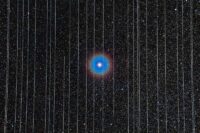Everything is composed of microscopic particles, such as protons, neutrons, electrons, etc. How do these microscopic particles move and what characteristics do they have? Scientists can only accelerate them through colliders and collide them to see if they still have structure and understand some of their physical characteristics.
The microcosm is very uncertain, or it is fuzzy. Superposition, measurement, Schrödinger’s cat, these nouns often appear. Here we don’t talk about cats, but just a simple particle, such as electrons. Electrons exist in atoms. We often compare atomic nuclei to stars, and electrons to planets , electrons revolve around a specific orbit around the nucleus. According to the view of quantum physics, electrons do not have orbits, nor do they revolve around the nucleus. Electrons can be in different positions at the same time, which sounds incredible. Different positions, this is the superposition state in quantum physics.
Microcosmic particles have this characteristic, why do objects composed of it lose this characteristic? In fact, it is not lost, just because of being observed, the superposition state is collapsed into a definite state. This is an often-cited observation in quantum physics. Just like Schrödinger’s cat, before observing, the cat is both dead and alive, once the lid is opened to observe, the cat is either dead or alive. Therefore, the superposition state exists in the microscopic level that cannot be observed, and there is no superposition state in the macroscopic level.
In 1957, physicist Hugh Everett proposed the concept of many worlds. Later, parallel time and space and parallel worlds in science fiction were only derivatives of the concept of many worlds. What does many worlds refer to? Let’s take the cat as an example. In fact, the moment the observer opens the lid, the universe splits into two possibilities. The cat in universe A is alive, and the cat in universe B is dead. , The observer in universe A opened the lid to take a look, and told his colleagues that the cat is alive, and the observer in universe B told his colleagues, look, the cat is dead. And the observers are also continuing to develop along different possible lines, though they are all the observers before the division.
If the universe is so easy to split, then there are already a lot of split universes, because physicists have done countless such observation experiments, so why haven’t we been lucky enough to witness ourselves in another universe once? ?
If there is a problem, there must be an explanation. This leads to the concept of decoherence in quantum physics. Take the cat as an example. Before the cover is opened, the life and death of the cat are a superposition state of mutual interference. This superposition state is in an independent space, and the outside world does not interfere with it. When the observer opens the cover, the The superposition state will interact with the external environment, and the interference between the two states will disappear. The interference disappears very quickly without leaving any traces, and the observer will only see one result.
Decoherence is also the reason why there is no inaccuracy at the macro level. Once it is observed, decoherence will occur. It is a very simple principle, because you have observed it, which means that it has been interfered by your observation. decoherence will occur.
The idea of many worlds has been widely debated in academic circles since it was proposed by a physicist in 1957, but it has also become a hot topic in science fiction. At present, it is not sure whether there are many worlds, because I have never been in contact with them, and the theory of decoherence needs to be more perfected, so I can only say that many worlds may exist, and parallel worlds may exist.




GIPHY App Key not set. Please check settings